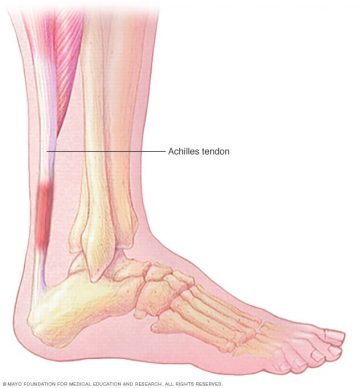Back to Pain Management Services
Achilles Tendonitis
overview
causes
symptoms
Treatment
Reviews
Overview
Achilles tendinitis is an overuse injury of the Achilles (uh-KILL-eez) tendon, the band of tissue that connects calf muscles at the back of the lower leg to your heel bone.
Achilles tendinitis most commonly occurs in runners who have suddenly increased the intensity or duration of their runs. It’s also common in middle-aged people who play sports, such as tennis or basketball, only on the weekends.
Most cases of Achilles tendinitis can be treated with relatively simple, at-home care under your doctor’s supervision. Self-care strategies are usually necessary to prevent recurring episodes. More-serious cases of Achilles tendinitis can lead to tendon tears (ruptures) that may require surgical repair.
Causes
- Repetitive or intense strain on the Achilles tendon.
- Weakening of the Achilles tendon due to aging.
- Physical problems: A naturally flat arch in your foot can put more strain on the Achilles tendon. Obesity and tight calf muscles also can increase tendon strain.
- Medical conditions: People who have psoriasis or high blood pressure are at higher risk of developing Achilles tendinitis.
Symptoms
The pain associated with Achilles tendinitis typically begins as a mild ache in the back of the leg or above the heel after running or other sports activity. Episodes of more-severe pain may occur after prolonged running, stair climbing or sprinting.
You might also experience tenderness or stiffness, especially in the morning, which usually improves with mild activity.

Treatment
If over-the-counter pain medications — such as ibuprofen (Advil, Motrin IB, others) or naproxen (Aleve) — aren’t enough, your doctor might prescribe stronger medications to reduce inflammation and relieve pain.
A physical therapist might suggest some of the following treatment options:
- Exercises. Therapists often prescribe specific stretching and strengthening exercises to promote healing and strengthening of the Achilles tendon and its supporting structures.
A special type of strengthening called “eccentric” strengthening, involving a slow let down of a weight after raising it, has been found to be especially helpful for persistent Achilles problems.
- Orthotic devices. A shoe insert or wedge that slightly elevates your heel can relieve strain on the tendon and provide a cushion that lessens the amount of force exerted on your Achilles tendon.
If several months of more-conservative treatments don’t work or if the tendon has torn, your doctor may suggest surgery to repair your Achilles tendon.
Reviews on our treatments
“I was looking for a Social Media Course to expand my career horizon. A friend of mine suggested to learn from Steve’s online courses and it really worked for me.”

Flora BakerNew York
“A fantastic and very engaging course. All of the information offered by Steve was completely practical, relevant and presented in an easy, digestible and interesting way.”

Glen StephensLondon
“This course was a breakthrough in my knowledge of digital marketing. The content is comprehensive and of great quality, engaging and interactive.”

Terry HigginsBerlin
Previous
Next

